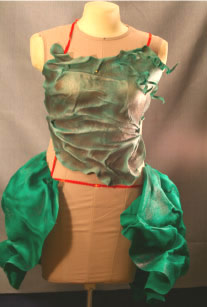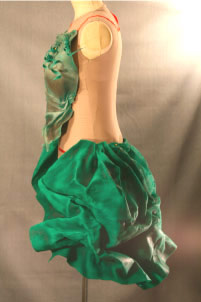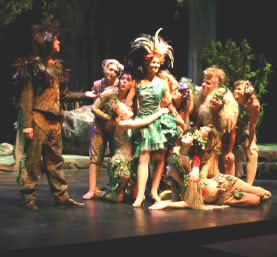Working with Wonderflex
by Ricky Greenwell, Minnesota State University, Moorhead
When I took over as designer at Minnesota State University Moorhead, I discovered that I had inherited a strange hard fabric. Not really knowing what it was or how to use it, I set it aside, figuring that I'd some day know what to do with it.
Last spring at USITT, I attended an excellent workshop on working with Vereform and thermo plastics. At that workshop I discovered that I was in possession of a type of thermo plastic fabric better kno ws as “wonderflex”. Knowing what I had, it was time to play and explore the possibilities that this amazing material provided. I would like to take some time and share with you some of the things I learned about this great fabric.
ws as “wonderflex”. Knowing what I had, it was time to play and explore the possibilities that this amazing material provided. I would like to take some time and share with you some of the things I learned about this great fabric.
Because wonderflex contains its own adhesive and is malleable with heat and pressure, it will easily bond to itself and to an assortment of other materials like leather, wood, and fabric. This helps eliminate the need for messy and/or hazardous solvents.
Depending on the size of your project, there are a number of ways you can form it. For smaller projects, such as masks, you can heat up water and simply dip the wonderflex in until it becomes pliable. Once it becomes pliable you can shape your mask to the desired shape over a mold. My most recent project involving wonderflex was a larger breastplate and bustle. The large size of the breastplate and bustle meant that hot water wasn't a good option. I utilized an industrial hot air gun, my steamer, and steam from my industrial iron to heat the material and shape it.
I learned that while using a hot air gun, you have to keep it moving and not focus on any one spot too long. Failing to do so will result in melting and charring of the fabric and material. The best advantage I found while using my iron was that it gave me steam as I needed it. You must exercise caution while using the iron, however. If you accidentally touch the wonderflex with the iron, you will melt the material and gum up the iron. The steamer was great because it always provides steam and it fits into the smaller places that would be difficult to safely reach with an iron. Wonderflex does not allow for the steam to pass through so care must be taken while using a steamer to avoid steam burns.
In my production o f A Midsummer Night's Dream I wanted Tatiana to have an organic looking armor. I decided that wonderflex would be the best option to achieve the look I was aiming for.
f A Midsummer Night's Dream I wanted Tatiana to have an organic looking armor. I decided that wonderflex would be the best option to achieve the look I was aiming for.
The first step in the process was to cut a piece of wonderflex large enough for the breastplate and the bustle. I formed the breastplate out of wonderflex once I'd heated it sufficiently using the techniques above. I used straight pins to hold the wonderflex in place and maintain its shape. Once the wonderflex cooled down it was set in the shape that I wanted. I used needle nose pliers to remove the straight pins. Although the straight pins left small holes, I was able to hide them in the folds and wrinkles of the breastplate. I worked the bustle in much the same process as the breastplate. I formed the shape of the bustle on a dress form that I had placed three panniers around. I gradually would heat the material, form the shape, and then let it cool down before moving on around the mannequin. I eventually achieved the look I was aiming for. With the bustle I wanted to achieve a flower petal-like shell. That was all that it took to make the foundation of my costume. Once the hardened wonderflex based shape was created, I used an airbrush to paint highlights and shadows. The final step was setting in grommets that would allow the costume to be tied onto an actress. The costume was finished.
Sources for Thermo Plastic Material
http://www.dazian.com/
http://www.artstuf.com/

